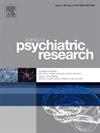基于脑血流和脑结构识别重度抑郁症:一项可解释的多模态学习研究。
IF 3.7
2区 医学
Q1 PSYCHIATRY
引用次数: 0
摘要
磁共振成像(MRI)为分析脑部疾病提供了对大脑结构和功能的非侵入性评估。近年来,随着多模态MRI数据的不断积累,整合各种模态的信息已成为提高脑部疾病检测的有效策略。本研究的重点是通过动脉自旋标记(ASL)灌注MRI结合结构MRI数据识别重度抑郁症(MDD)。我们收集了260名参与者的ASL和结构MRI数据,其中包括169名重度抑郁症患者和91名健康对照。我们开发了一种可解释的融合方法来识别MDD,利用ASL灌注MRI的脑血流量(CBF)数据和结构MRI的脑组织体积。该融合模型集成了多模态数据,显示了对MDD的卓越预测性能。通过将MRI区域体积与CBF数据相结合,我们获得了比单独使用每种模式更有效的结果。此外,我们分析了特征的重要性和相互作用来解释融合模型。我们确定了14个重要特征,包括8个区域卷和6个区域CBF措施,它们在MDD的识别中发挥了关键作用。此外,我们发现重要特征之间有3个特征交互作用,结构特征与功能特征之间有7个特征交互作用,这些交互作用在模型中尤为突出。本研究结果表明,融合ASL和结构MRI数据的融合学习方法在检测MDD方面是有效的。此外,研究表明,模型解释方法可以揭示影响模型决策的关键特征,以及这些关键特征之间或功能特征与结构特征之间的潜在相互作用,以识别MDD。本文章由计算机程序翻译,如有差异,请以英文原文为准。
Identifying major depressive disorder based on cerebral blood flow and brain structure: An explainable multimodal learning study
Magnetic resonance imaging (MRI) offers non-invasive assessments of brain structure and function for analyzing brain disorders. With the increasing accumulation of multimodal MRI data in recent years, integrating information from various modalities has become an effective strategy for improving the detection of brain disorders. This study focuses on identifying major depressive disorder (MDD) by using arterial spin labeling (ASL) perfusion MRI in conjunction with structural MRI data. We collected ASL and structural MRI data from 260 participants, including 169 MDD patients and 91 healthy controls. We developed an explainable fusion method to identify MDD, utilizing cerebral blood flow (CBF) data from ASL perfusion MRI and brain tissue volumes from structural MRI. The fusion model, which integrates multimodal data, demonstrated superior predictive performance for MDD. By combining MRI regional volumes with CBF data, we achieved more effective results than using each modality independently. Additionally, we analyzed feature importance and interactions to explain the fusion model. We identified fourteen important features, comprising eight regional volumes and six regional CBF measures, that played a crucial role in the identification of MDD. Furthermore, we found three feature interactions among the important features and seven interactions between structural and functional features, which were particularly prominent in the model. The results of this study suggest that the fusion learning approach, which integrates ASL and structural MRI data, is effective in detecting MDD. Moreover, the study demonstrates that the model explanation method can reveal key features that influence the decisions of models, as well as potential interactions among these key features or between functional and structural features in identifying MDD.
求助全文
通过发布文献求助,成功后即可免费获取论文全文。
去求助
来源期刊

Journal of psychiatric research
医学-精神病学
CiteScore
7.30
自引率
2.10%
发文量
622
审稿时长
130 days
期刊介绍:
Founded in 1961 to report on the latest work in psychiatry and cognate disciplines, the Journal of Psychiatric Research is dedicated to innovative and timely studies of four important areas of research:
(1) clinical studies of all disciplines relating to psychiatric illness, as well as normal human behaviour, including biochemical, physiological, genetic, environmental, social, psychological and epidemiological factors;
(2) basic studies pertaining to psychiatry in such fields as neuropsychopharmacology, neuroendocrinology, electrophysiology, genetics, experimental psychology and epidemiology;
(3) the growing application of clinical laboratory techniques in psychiatry, including imagery and spectroscopy of the brain, molecular biology and computer sciences;
 求助内容:
求助内容: 应助结果提醒方式:
应助结果提醒方式:


